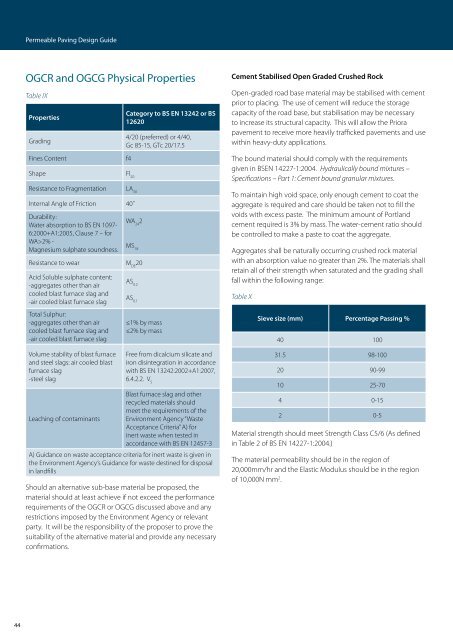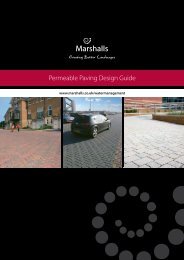Create successful ePaper yourself
Turn your PDF publications into a flip-book with our unique Google optimized e-Paper software.
44<br />
<strong>Permeable</strong> <strong>Paving</strong> <strong>Design</strong> <strong>Guide</strong><br />
OGCR and OGCG Physical Properties<br />
Table IX<br />
Properties<br />
Grading<br />
Fines Content f4<br />
Shape Fl 20<br />
Resistance to Fragmentation LA 30<br />
Internal Angle of Friction 40˚<br />
Durability:<br />
Water absorption to BS EN 1097-<br />
6:2000+A1:2005, Clause 7 – for<br />
WA>2% -<br />
Magnesium sulphate soundness.<br />
Category to BS EN 13242 or BS<br />
12620<br />
4/20 (preferred) or 4/40,<br />
Gc 85-15, GTc 20/17.5<br />
WA 24 2<br />
MS 18<br />
Resistance to wear M DE 20<br />
Acid Soluble sulphate content:<br />
-aggregates other than air<br />
cooled blast furnace slag and<br />
-air cooled blast furnace slag<br />
Total Sulphur:<br />
-aggregates other than air<br />
cooled blast furnace slag and<br />
-air cooled blast furnace slag<br />
Volume stability of blast furnace<br />
and steel slags: air cooled blast<br />
furnace slag<br />
-steel slag<br />
AS 0.2<br />
AS 0.1<br />
≤1% by mass<br />
≤2% by mass<br />
Free from dicalcium silicate and<br />
iron disintegration in accordance<br />
with BS EN 13242:2002+A1:2007,<br />
6.4.2.2. V 5<br />
Blast furnace slag and other<br />
recycled materials should<br />
meet the requirements of the<br />
Leaching of contaminants Environment Agency “Waste<br />
Acceptance Criteria” A) for<br />
inert waste when tested in<br />
accordance with BS EN 12457-3<br />
A) Guidance on waste acceptance criteria for inert waste is given in<br />
the Environment Agency’s Guidance for waste destined for disposal<br />
in landfills<br />
Should an alternative sub-base material be proposed, the<br />
material should at least achieve if not exceed the performance<br />
requirements of the OGCR or OGCG discussed above and any<br />
restrictions imposed by the Environment Agency or relevant<br />
party. It will be the responsibility of the proposer to prove the<br />
suitability of the alternative material and provide any necessary<br />
confirmations.<br />
Cement Stabilised Open Graded Crushed Rock<br />
Open-graded road base material may be stabilised with cement<br />
prior to placing. The use of cement will reduce the storage<br />
capacity of the road base, but stabilisation may be necessary<br />
to increase its structural capacity. This will allow the Priora<br />
pavement to receive more heavily trafficked pavements and use<br />
within heavy-duty applications.<br />
The bound material should comply with the requirements<br />
given in BSEN 14227-1:2004. Hydraulically bound mixtures –<br />
Specifications – Part 1: Cement bound granular mixtures.<br />
To maintain high void space, only enough cement to coat the<br />
aggregate is required and care should be taken not to fill the<br />
voids with excess paste. The minimum amount of Portland<br />
cement required is 3% by mass. The water-cement ratio should<br />
be controlled to make a paste to coat the aggregate.<br />
Aggregates shall be naturally occurring crushed rock material<br />
with an absorption value no greater than 2%. The materials shall<br />
retain all of their strength when saturated and the grading shall<br />
fall within the following range:<br />
Table X<br />
Sieve size (mm) Percentage Passing %<br />
40 100<br />
31.5 98-100<br />
20 90-99<br />
10 25-70<br />
4 0-15<br />
2 0-5<br />
Material strength should meet Strength Class C5/6 (As defined<br />
in Table 2 of BS EN 14227-1:2004.)<br />
The material permeability should be in the region of<br />
20,000mm/hr and the Elastic Modulus should be in the region<br />
of 10,000N mm 2 .<br />
DBM<br />
The DBM (Dense Base Macadam) can be installed within the<br />
design where additional structural support or temporary<br />
running surface is required for site traffic over the recently laid<br />
20mm Priora sub-base aggregate.<br />
The material should be a 0/32mm size dense base as given in<br />
BS4987-1:2005, Coated macadam (asphalt concrete) for roads and<br />
other paved areas – Part 1: Specification for constituent materials<br />
and for mixtures, clause 5.2. Typically the binder will be a<br />
50 pen according to clause 4.7 of BS4987-1:2005 but can vary<br />
dependent on loading conditions.<br />
Priora Laying Course Aggregate<br />
Specification<br />
The large size of sub-base material aggregate creates an uneven<br />
surface when compacted and has an open textured surface.<br />
The laying course material provides a flatter platform onto which<br />
the blocks are laid, to prevent any rocking or instability of the<br />
blocks in-situ.<br />
www.marshalls.co.uk/watermanagement<br />
The Priora Laying Course should be graded as below:<br />
Table XI<br />
Recommended BS EN 12620<br />
aggregate grading (mm)<br />
Recommended BS EN 12620<br />
grading / tolerance category<br />
Table XII<br />
Sieve size (mm)<br />
31.5<br />
20<br />
Laying Course Grading<br />
Grading Details<br />
2/6.3<br />
Gc80/20<br />
Percentage by mass passing ISO<br />
565 sieve<br />
14 100<br />
10 98 to 100<br />
6.3 80 to 99<br />
4<br />
2 0 to 20<br />
1 0 to 5<br />
0.063 0 to 2<br />
BS 7533-13:2009 states that only the grading of the laying course<br />
should be tested, as it is not possible to test to the same physical<br />
properties of the sub-base aggregate but the source material of<br />
the 2-6.3mm should achieve the same values.<br />
45



